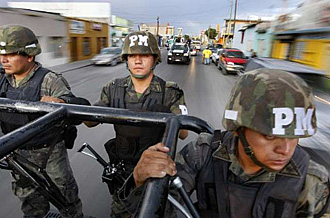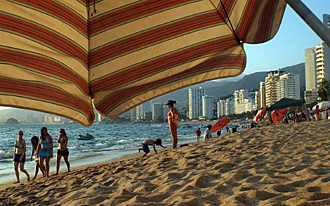
|  |  |  Travel & Outdoors Travel & Outdoors  
Mexico’s Violence: A 12-Point Update for Travelers
 Christopher Reynolds - Los Angeles Times Christopher Reynolds - Los Angeles Times
go to original
August 12, 2010


| | Troops patrol Ciudad Juárez, Mexico, in 2009, a year when more than 2,600 killings were logged in the border city. (Don Bartletti/Los Angeles Times) | 
| | Sunset at the beach in Acapulco, Mexico. In its latest Mexico travel warning, the State Department didn’t urge Americans to avoid the popular resort, but it did cite an April shootout between police and drug traffickers that killed three bystanders. (Sarah Meghan Lee/Los Angeles Times) |  |
Brace yourselves, aficionados de Mexico. The U.S. State Department’s latest Mexican travel warning runs to eight pages — a detailed and harrowing document that should persuade any sane tourist to stay away from Ciudad Juárez and take extreme care in other border-state cities such as Tijuana, Nogales, Nuevo Laredo, Monterrey and Matamoros.

But when it comes to many other Mexican destinations, including the palm-lined beaches and colonial cities that many Americans savor, the State Department’s advice, updated on July 16, is more nuanced.

In the nearly four years since President Felipe Calderon declared war on that country’s drug cartels, more than 28,000 people, according to some estimates, have been killed in drug-related violence — yet millions of American travelers have also visited without incident during the same time.

U.S. officials note that “the great majority” of the deaths have been members of drug-trafficking organizations, but many innocent bystanders have been victimized as well. Also, the warning says, dozens of U.S. citizens living in Mexico have been kidnapped in recent years, and most of those cases remain unsolved.

If you’re seriously considering any Mexican journey — and it is a big country, with widely varying conditions from one area to another — you can begin by reading the State Department’s latest assessment followed, perhaps, by second and third opinions from the diplomats of Canada and Britain.

But for now, here are 12 points from U.S. officials’ July 16 warning:

1. Americans should defer unnecessary travel to Culiacán (capital of the state of Sinaloa). The State Department doesn’t make the same assertion for the beach city of Mazatlán, which is also in Sinaloa, but it says Mazatlán “has experienced a recent increase in violent crime, with more murders in the first quarter of 2010 than in all of 2009.”

2. The announcement doesn’t urge Americans to avoid Acapulco, which is in Guerrero state. But it does cite an April shootout between police and drug traffickers that killed three bystanders.

3. It also isn’t steering everyone away from Cuernavaca (a city in Morelos state that attracts many language students). But it does mention “numerous incidents of drug-related violence” there, also in April.

4. The announcement isn’t quite asking Americans to dodge Copper Canyon, site of remarkable geography and a storied railroad in the state of Chihuahua. But it does point out that “there have been recent incidents of serious narcotics-related violence in the vicinity of the Copper Canyon in Chihuahua.”

5. In the state of Guerrero, the State Department says, Americans should avoid “the dangerous, isolated road” through Ciudad Altamirano to the beach resorts of Ixtapa and Zihuatanejo.

6. Except for the city of Tijuana (mentioned as a site of frequent violence), the states of Baja California and Baja California Sur go unmentioned in the new warning — a reassuring omission for anybody wondering about major Baja destinations such as Los Cabos, La Paz and Loreto.

7. The State Department on July 15 forbade most employees and their families from traveling by land “across the U.S.-Mexico border to or from any post in the interior of Mexico.”

8. The U.S. Consulate General in Nuevo Laredo (in the state of Tamaulipas) forbids its own employees from entering the Nuevo Laredo entertainment zone known as “Boys Town.”

9. U.S. Embassy employees are forbidden from hailing taxis on the street in Mexico City because of frequent robberies.

10. At least 1 million U.S. citizens continue to live in Mexico.

11. Americans should stay away from the state of Michoacán, which includes a world-famous butterfly sanctuary and the colonial capital city of Morelia.

12. Besides avoiding Ciudad Juárez (more than 2,600 killings in 2009) and the Guadalupe Bravo area southeast of Juárez, Americans should defer travel to the northwest quarter of the state of Chihuahua (which includes the city of Nuevas Casas Grandes).

Oh, and one more thing: Mexico’s hurricane season, on both Pacific and Atlantic sides, typically runs June through November. |

 |
|  |



